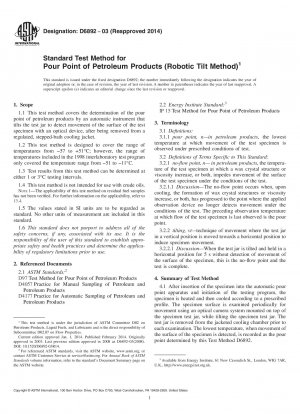ASTM D6892-03(2014)
Standard Test Method for Pour Point of Petroleum Products 40;Robotic Tilt Method41;
- Standard No.
- ASTM D6892-03(2014)
- Release Date
- 2003
- Published By
- American Society for Testing and Materials (ASTM)
- Status
- Replace By
- ASTM D6892-03(2020)
- Latest
- ASTM D6892-03(2020)
- Scope
5.1 The pour point of a petroleum product is an index of the lowest temperature of its utility for certain applications. Flow characteristics, such as pour point, can be critical for the correct operation of lubricating systems, fuel systems, and pipeline operations.
 FIG. 1 Schematic of Cooling/Heating Block and Cooling Circulating Bath
FIG. 1 Schematic of Cooling/Heating Block and Cooling Circulating Bath5.2 Petroleum blending operations require precise measurement of the pour point.
5.3 Test results from this test method can be determined at either 1 or 3°C intervals.
5.4 This test method yields a pour point in a format similar to Test Method D97 or IP8201;15, when the 3°C interval results are reported.
Note 2—Since some users may wish to report their results in a format similar to Test Method D97 or IP8201;15 (in 3°C intervals) the precision data were derived for the 3°C intervals. For statements on bias relative to Test Method D97 or IP8201;15, see the research report.5.5 This test method has comparable repeatability and better reproducibility relative to Test Method D97 or IP8201;15 as measured in the 1998 interlaboratory program (see Section 13).
1.1 This test method covers the determination of the pour point of petroleum products by an automatic instrument that tilts the test jar to detect movement of the surface of the test specimen with an optical device, after being removed from a regulated, stepped-bath cooling jacket.
1.2 This test method is designed to cover the range of temperatures from −57 to +51°C; however, the range of temperatures included in the 1998 interlaboratory test program only covered the temperature range from −51 to −11°C.
1.3 Test results from this test method can be determined at either 1 or 3°C testing intervals.
1.4 This test method is not intended for use with crude oils.
Note 1—The applicability of this test method on residual fuel samples has not been verified. For further information on the applicability, refer to 13.4.1.5 The values stated in SI units are to be regarded as standard. No other units of measurement are included in this standard.
1.6 This standard does not purport to address all of the safety concerns, if any, associated with its use. It is the responsibility of the user of this standard to establish appropriate safety and health practices and determine the applicability of regulatory limitations prior to use.
ASTM D6892-03(2014) Referenced Document
- ASTM D4057 Standard Practice for Manual Sampling of Petroleum and Petroleum Products
- ASTM D4177 Standard Practice for Automatic Sampling of Petroleum and Petroleum Products
- ASTM D97 Standard Test Method for Pour Point of Petroleum Products
ASTM D6892-03(2014) history
- 2020 ASTM D6892-03(2020) Standard Test Method for Pour Point of Petroleum Products (Robotic Tilt Method)
- 2003 ASTM D6892-03(2014) Standard Test Method for Pour Point of Petroleum Products 40;Robotic Tilt Method41;
- 2008 ASTM D6892-03(2008) Standard Test Method for Pour Point of Petroleum Products (Robotic Tilt Method)
- 2003 ASTM D6892-03 Standard Test Method for Pour Point of Petroleum Products (Robotic Tilt Method)
